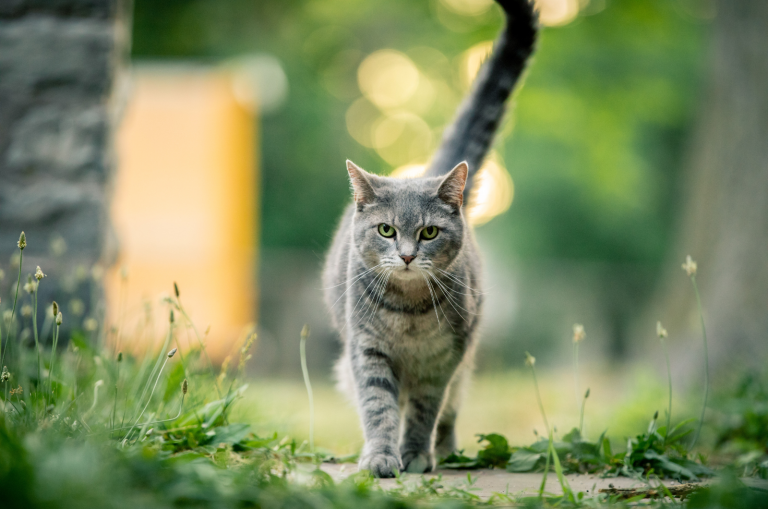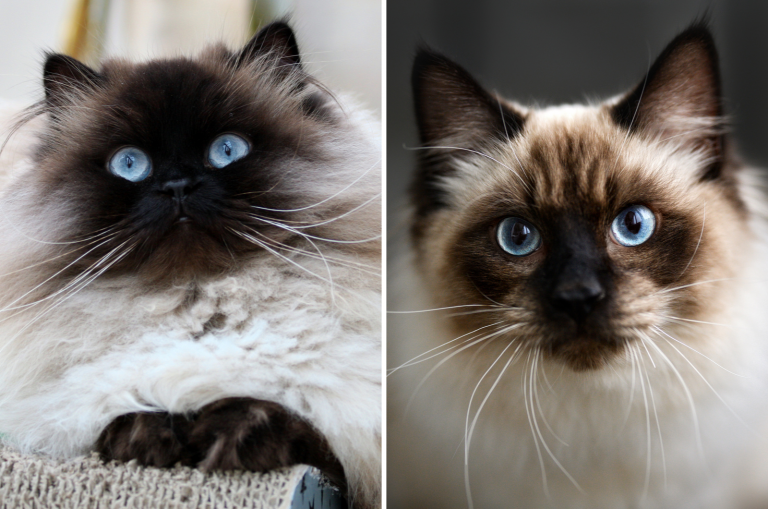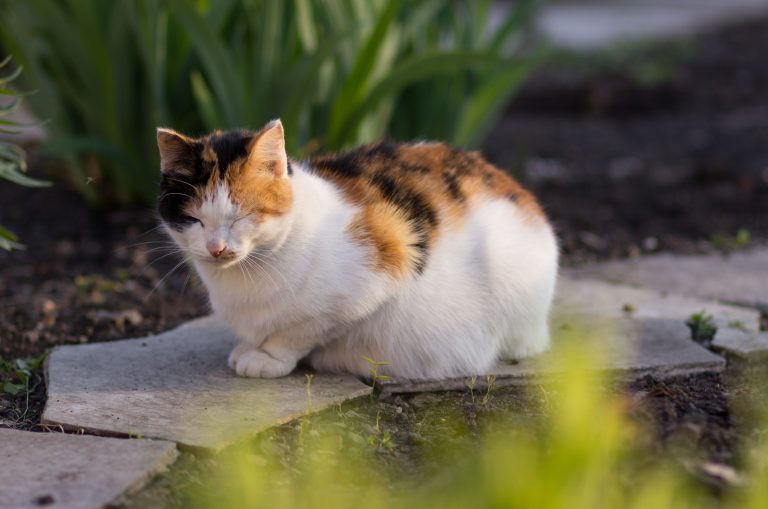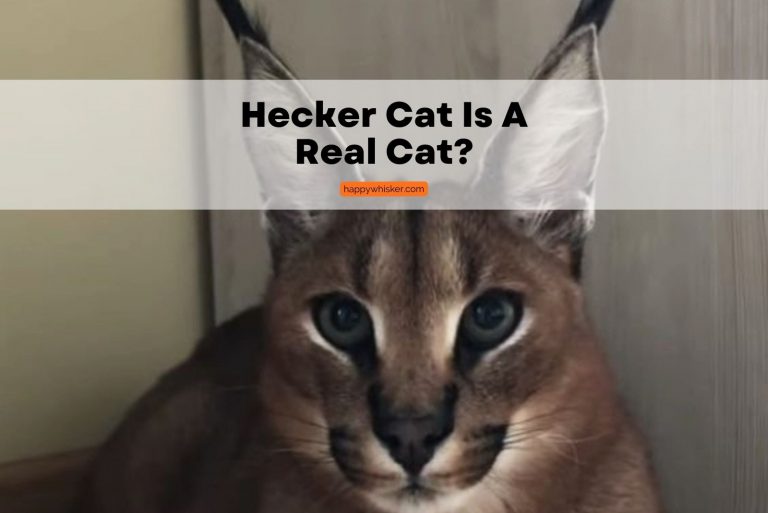Cat Sneezing And Watery Eyes – Causes And Treatments
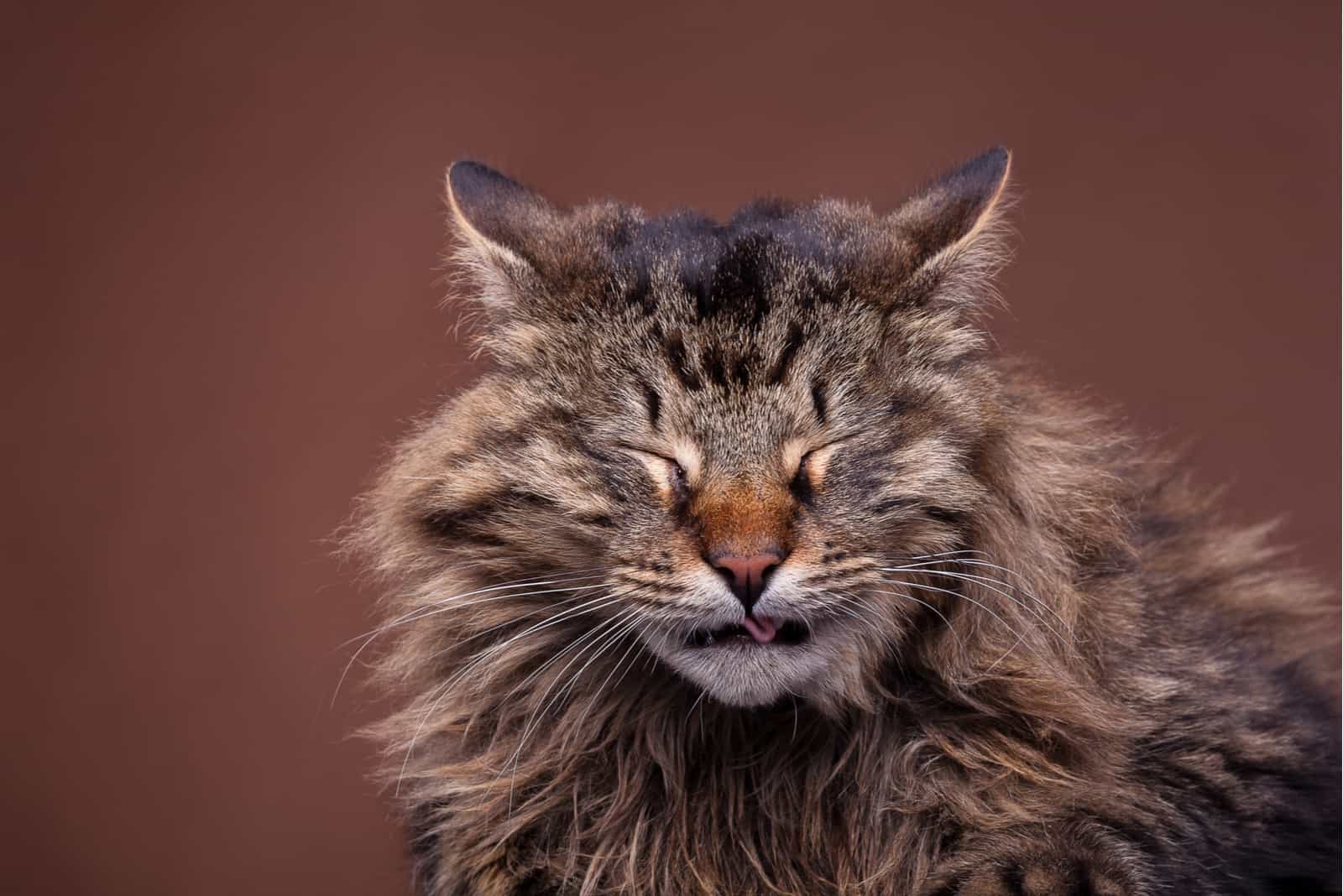
You should not have to worry about an occasional sneeze here and there! We all have them and they are harmless!
But you might have noticed your cat is not it’s usual self – constantly pawing at the eyes, squinting, having teary-eyes and sneezing.
Your cat sneezing and having watery eyes is a common symptom of an allergic reaction or a common cold. But there are also a couple of more serious eye and respiratory diseases that manifest in these symptoms too!
This article provides an answer to What are the causes of cat sneezing and watery eyes and What can I do to prevent or treat it?. Keep on reading to find out!
5 Possible Causes Of Your Cat Sneezing And Watery Eyes!
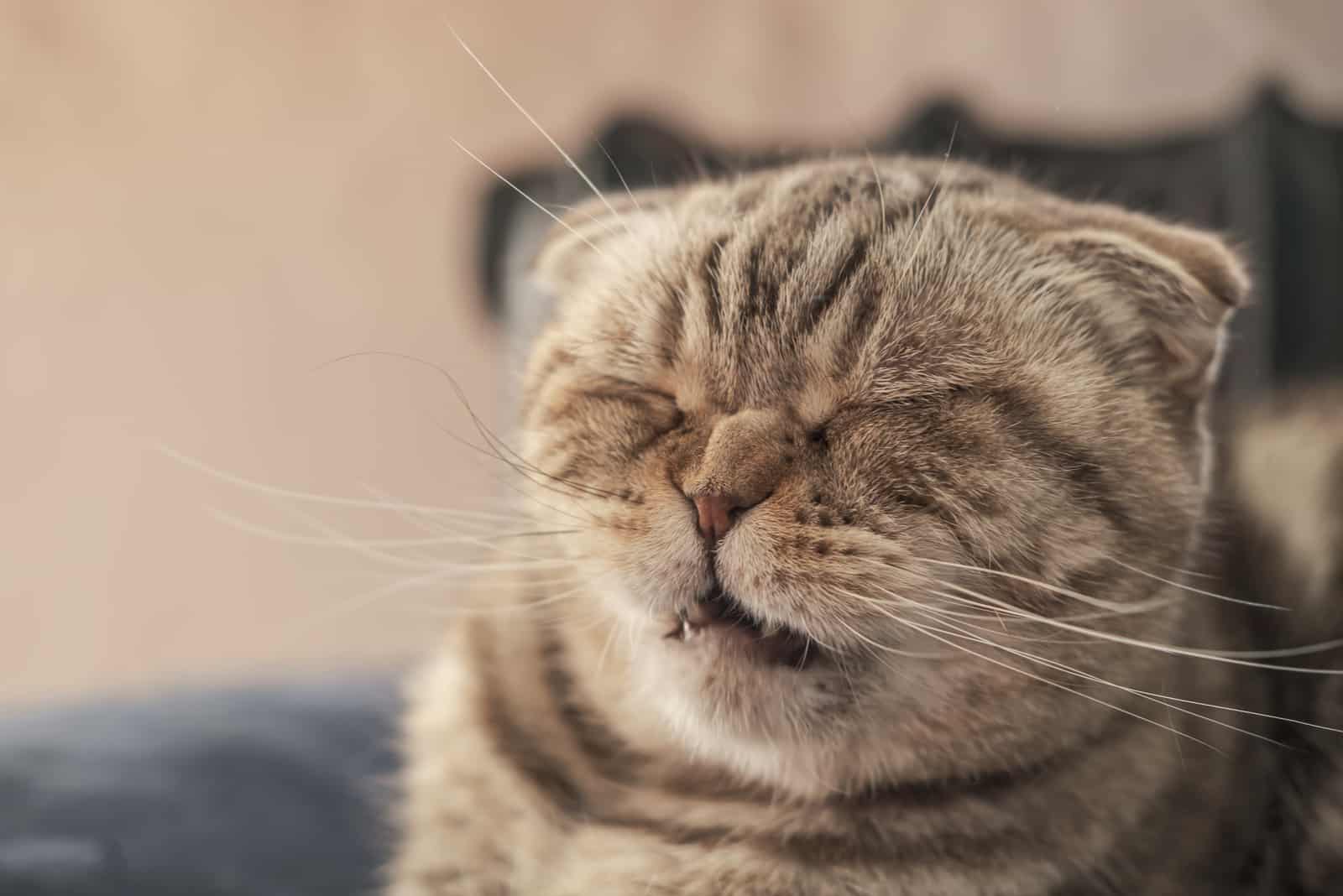
Below are some of the most common reasons for a cat sneezing and suffering from watery eyes. Some are pretty harmless, as you will see, while others can be dangerous for your cat’s health.
Let’s get right into it!
1. Eye Irritants
The most common, and fortunately the most harmless, reason for your cat sneezing and having watery eyes is irritation of the eyes. One or both of your cat’s eyes can become irritated by a number of different things. The most frequent irritants are listed below.
Allergens
Just like humans, cats can be allergic to many different things. Allergens are substances that cause an allergic reaction that triggers the immune system to react. The list of allergens is pretty long, but the most common cat (and also human) allergens are:
• pollen
• mold
• fungi
• dust
• food allergens
• flea bites (flea toxins to be more specific)
If you suspect the reason for cat sneezing and watery eyes is allergies, look out for these symptoms:
• sneezing and watery eyes (obviously)
• coughing
• wheezing
• itchy eyes
• red skin
Foreign Body
Your cat just might have something stuck in its eye such as a tiny stone or a fly. The body’s natural reaction is to produce tears to clear the eye out by watering out the foreign body. Your cat might try pawing its eyes.
Strong Chemicals
All of us have felt the burning sensation in the eyes that comes whenever there is a strong smell of a cleaning product. This is most common when using harsh cleaning products.
The strong chemicals in the air that come from a cleaning product can be the source of your cat’s eyes watering. The same goes for strong perfumes and wall-paints!
2. Feline Upper Respiratory Infection
Feline URI is very similar to the common colds that humans experience. Feline URI is an infection of the lining of the nose, throat and sinuses.
It can be caused by either a virus or bacteria.
When it comes to bacteria, Bordetella and Chlamydophila felis are the likely culprits. As for viruses, feline herpesvirus type-1 and feline calicivirus are known to be the most common causes of URI. These two viruses are behind 90% of all cases of cat URI. This is why you need your cat vaccinated against these two viruses!
Both the bacteria and the viruses that cause URI are highly contagious. They are found in nose and eye secretions. Your cat can get it from close contact with another cat, or by eating or drinking from the bowl of an infected cat.
Symptoms Of Feline URI include the following:
• Sneezing
• Nasal Discharge
• Eye Discharge
• Blockage Of The Nasal Passages
• Runny Nose
• Ulcers in the mouth
• Drooling and breathing through mouth
• Squinting
• Not eating
• Lethargy
• Fever
3. Feline Rhinitis
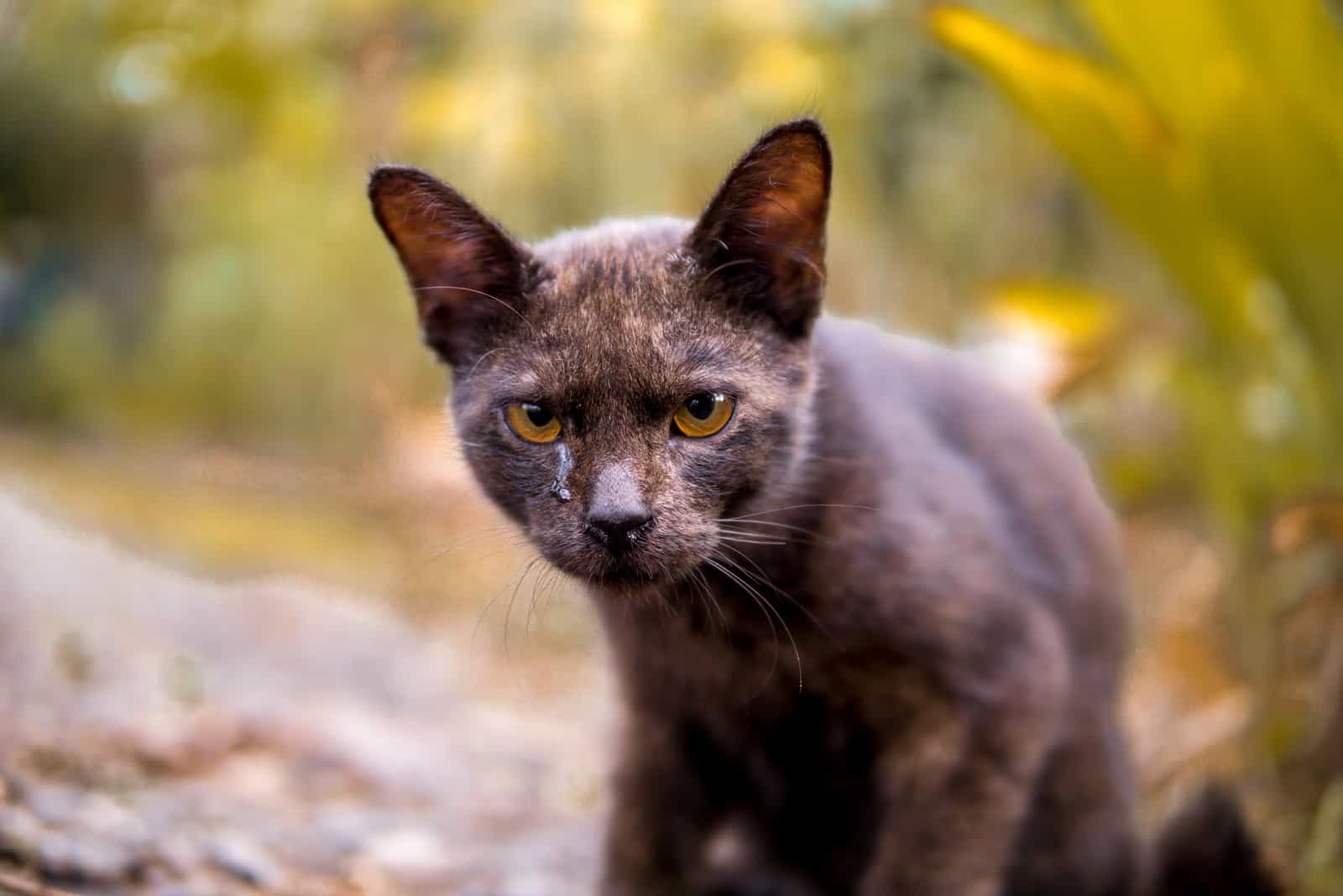
Rhinitis is the inflammation of the mucous membrane that lines the nose.
It is accompanied by:
• swelling of the nasal passage – making breathing difficult,
• runny nose
• nasal congestion due to increased nasal mucus.
• watery eyes (in the case of allergic rhinitis)
What Causes Rhinitis?
In the case of nonallergic rhinitis, causative agents include feline herpesvirus, feline calicivirus, bacterial infections, fungal infections, and in rare cases cancer.
How Long Does It Last?
Rhinitis can be acute and chronic. If it is acute, it will last a few weeks. If it’s chronic, it may last for a number of years.
Chronic rhinitis is dangerous because the inflammation is persistent, which can lead to the permanent damage of the lining of the nose. This makes the nose a high-risk area for developing a secondary bacterial infection, as well as the inflammation already present.
4. Conjunctivitis/ Pinkeye
Conjunctivitis is an inflammation of the mucous membrane (called conjunctiva) that lines the eye and the outer surface of the eyelid. It is a fairly common eye disorder among felines and nothing to be overly concerned about.
The tell-tale symptoms of pinkeye are:
• frequent blinking
• squinting
• inability to fully open the eyes
• sensitivity to light
• eye discharge (can be watery or dark-colored)
• pawing at the infected eye
Conjunctivitis can be caused by allergens, but more often the source is bacteria such as mycoplasma or Chlamydia bacterium. Conjunctivitis can also arise due to a viral infection by the herpes virus.
It is most commonly observed in young cats, but all cats are susceptible to pinkeye. It is usually resolved without the need for medication. If your cat is dealing with herpesvirus, it is possible for the inflammation to return a few times.
5. Feline Glaucoma
Feline glaucoma is an eye disease characterized by the inability of the eye to properly drain the aqueous humor (a watery fluid in the front part of the eye, behind the lens). When this liquid accumulates, it creates pressure on the optic nerve.
The optic nerve is critical to a cat’s (or any other animal’s) vision because it transmits the information from the brain to the eye and vice versa. Pressure on this nerve can damage the nerve – and this can potentially lead to blindness.
Symptoms of feline glaucoma are:
• Watery eye discharge
• Eye being partially closed
• Pawing at the affected eye
• Swelling and bulging of the eyeball
• Eye becoming progressively cloudy
• Losing interest in daily activities
• Hiding and depression
5 Things You Can Do To Help Your Cat!
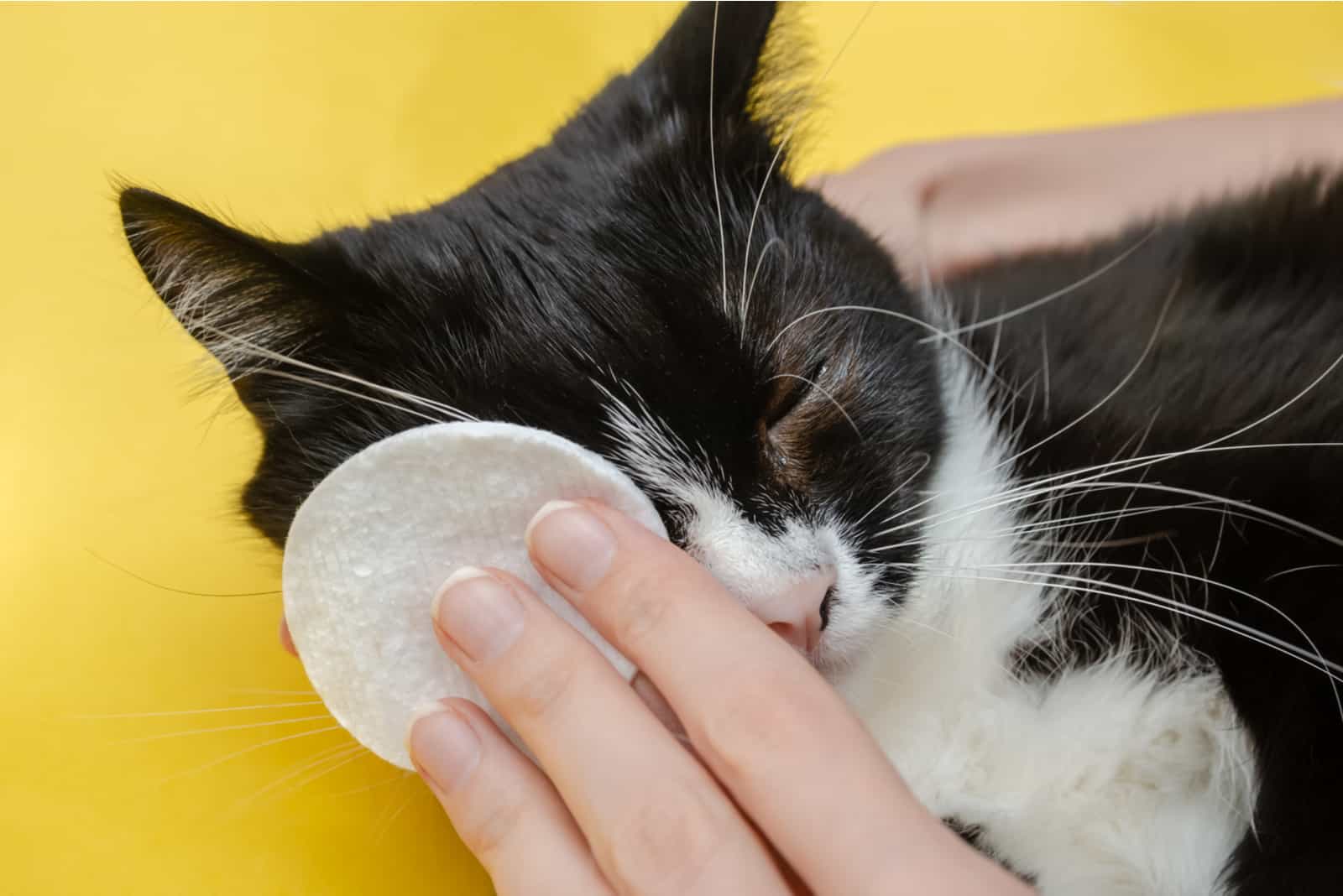
All of us want our pets to be safe, healthy, and happy. If anything you have read has made you worried – please do not be! With proper care and a quick trip to the vet, everything should be okay!
Here are some things you can try to do in order to keep your pet healthy!
1. Remove Possible Irritants From The Environment
If you know that the cause of your cat’s runny eyes is allergens, then try to get rid of them as much as possible. Keep your house dust-free and mold-free. Try using dust-free cat litter for the litter box, in case your cat is dust-sensitive.
When you’re cleaning and using a strong cleaning product or painting the walls of the house, put your cat in another room. That way, you can prevent your cat being in an environment with irritating, air-borne chemicals.
2. Treat URI On Time And Make Sure Your Cat Is Vaccinated
The usual treatment of feline upper respiratory tract infection is symptomatically, at home.
It’s important to notice the symptoms of URI on time, in order to stop the development of a more serious health condition. Disease spreading onto the lungs is not good, as it can lead to pneumonia. This is rather rare, but it is a possible scenario.
Treatment For Feline URI
• antibiotics (if the causative agent is a bacterium)
• antiviral medication (if the causative agent is a virus)
• lysine supplements (reduces the symptoms)
• time in a humid-air environment (while you’re showering or in a room with a humidifier)
When Is It The Time To Visit The Vet?
• if your cat has difficulty breathing
• if your cat stops eating
• if your cat is vomiting for longer than a day
• if you see no improvement in your cat’s health after a week of at-home treatment
There is a possibility of a URI becoming a chronic condition, accompanied by chronic sneezing, frequent eye infections and nose ulcers. If this is the case with your cat, then symptom-relieving treatments are extremely important!
If your cat does not respond to treatments, it may be time to test for the possible presence of feline leukemia and feline immunodeficiency virus.
In order to prevent any of this from happening, vaccinate your cat on time. This vaccine is first given at 8 weeks of age and then a booster shot is needed. Your vet will provide you with the best information!
3. Treatment For Rhinitis
If you suspect your cat has rhinitis, we recommend you first try some at-home treatments in order to reduce the symptoms. If at-home care is not working, go to the vet. The vet will prescribe you proper medication and tell you if your cat is actually suffering from this disease.
Symptom-relieving treatments you should try!
• Make the air in the room humid and warm
Humidifiers are your best friend. Dry air makes the symptoms of nasal inflammation even worse, leading to difficult and painful breathing.
Humidity in the air makes your cat’s breathing easier and less painful. If you don’t have a humidifier, we recommend investing in one, not least because they help when humans have difficulty breathing too!
• Clean your cat’s face regularly
If your cat is experiencing nasal and eye discharge, make sure to clean it off your cat’s face frequently. This will make for a clean kitty and relieve any discomfort. Simply use a wet cloth, towel or even tissues and wipe the discharge off.
• Make sure your cat is comfortable
If your furry friend is really not feeling well, make sure the other family members and pets are not constantly bothering your cat. Provide a calm corner your cat can rest in. Make sure to keep your cat warm and well-fed also.
4. If Your Cat Has Conjunctivitis
Most cases of conjunctivitis are resolved without medication. Sometimes, however, the treatment can include antibiotics or antiviral medication – depending on the cause of the inflammation. Some eye drops can be useful to help soothe the eye.
If you observe that the inflammation is not going away on its own and the symptoms are still present then it’s time to go to the vet. Whatever the cause of the conjunctivitis, the rule is: the sooner it is treated, the better!
5. If Your Cat Has Feline Glaucoma
The progression of feline glaucoma is not sudden – it happens gradually over the course of a few months or longer.
Significant changes in your cat’s vision may only be noticed in the late stages of the disease. This is due to the fact that cats often continue with their daily activities, even if they do experience eye discomfort or partial vision loss.
Of course, if you suspect your feline friend is suffering from glaucoma, go immediately to the vet. It is relatively easy to diagnose, so your vet can tell you what to do next.
Unfortunately, most cases of glaucoma are caught in the late stages when symptoms are pretty obvious. Glaucoma is incurable but there are ways to help with the pain caused by this disease. Proper veterinary care is crucial for providing relief to a cat that has this disease.
FAQ
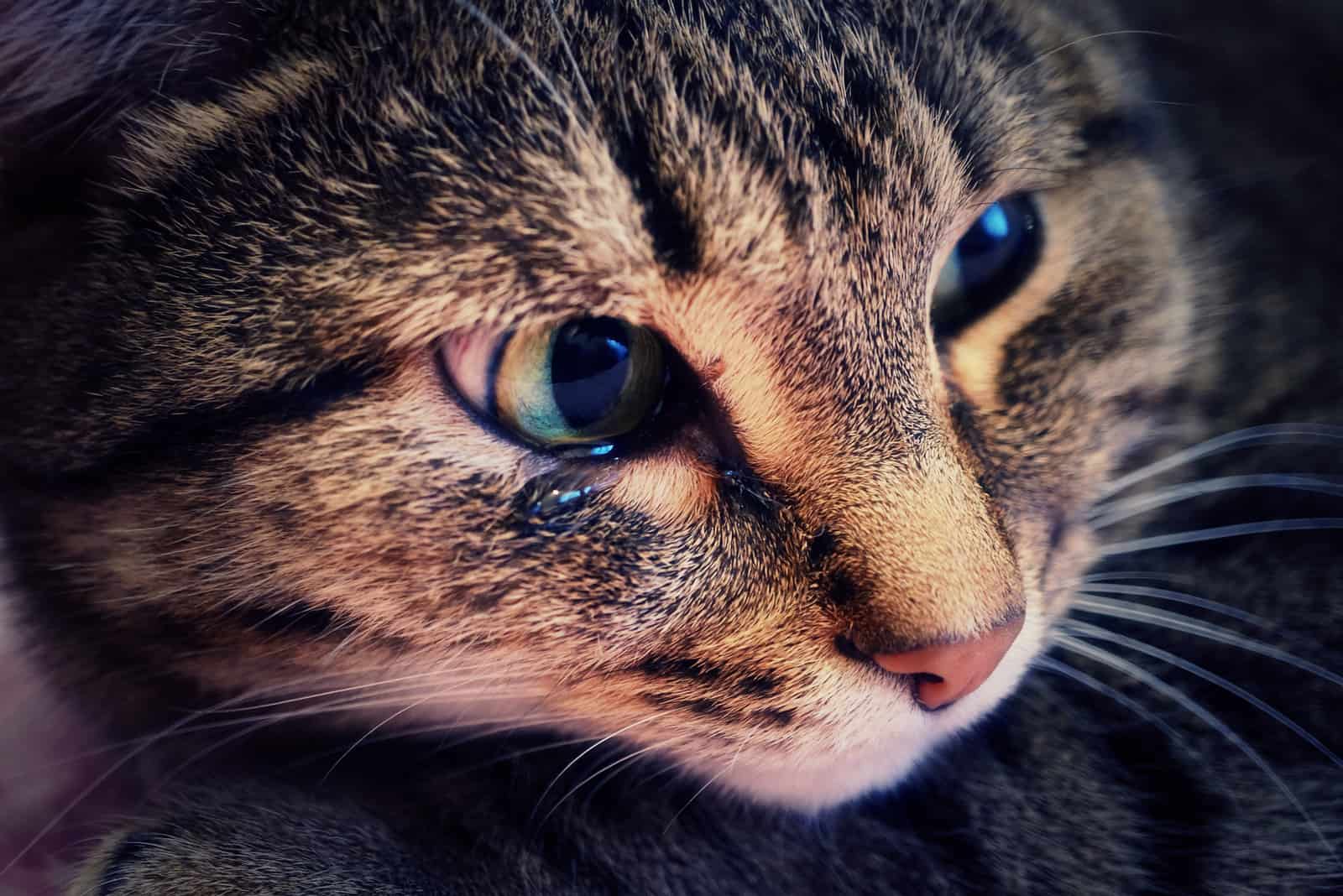
Here are some quick answers to commonly asked questions, in case you missed the answer in the article.
What To Do If My Cat Is Sneezing And Has Watery Eyes?
Try answering these questions:
• Is there something in your cat’s eye?
• Is it allergy season or was your cat exposed to something it is allergic to?
• Does your cat have symptoms of feline upper respiratory infection? Was your cat around any other cats? This is the most common way of contracting this disease, as it is very contagious.
• Does your cat have any symptoms of rhinitis, conjunctivitis, or feline glaucoma?
Based on your answers to these questions, you can decide what the right thing to do is. Try removing potential allergens and harsh chemicals, and if you think your cat has feline URI, rhinitis or conjunctivitis then try treating it at home. If at-home treatment is not working, go to the vet, especially if you suspect feline glaucoma.
Do Cat Colds Go Away On Their Own?
Yes, they mostly do. Your task as a pet owner is to try to relieve the symptoms of the cold. That is the main thing you can do.
A cold lasts up to 10 days maximum and your cat should be improving day by day.
If you notice the cold is not going away or getting better, then we suggest you go to the vet’s office for a quick check-up – but don’t worry, your cat is likely to be okay!
How Can I Treat My Cat’s Cold Without Going To The Vet?
You can help your cat by relieving the symptoms of the cold. The cold itself will go away on its own as your cat’s immune system fights it off.
Try using a humidifier to make the air more moist – that will help your cat’s nose pain and make breathing a lot easier. Make sure your cat eats – that is crucial.
Your cat’s immune system needs to be strong in order to fight, so fueling up is very important.
Use a warm cloth to wipe the nose and/or eye discharge from your cat’s face. Make sure your furry friend is warm and comfortable and then all you can do is wait it out.
When Should I Worry About My Cat Sneezing?
Occasional sneezing is perfectly normal. The presence of an allergen in the environment is a possible cause of occasional sneezing.
However, if the sneezing persists and you find your cat sneezing often, it may have a feline URI. Feline upper respiratory infection is an extremely common cause of sneezing, so sneezing is a universal clue for the presence of URI.
What Are The Symptoms Of A Cat Cold?
Cat cold, otherwise known as feline upper respiratory infection (URI) is pretty common and the symptoms are easy to spot:
• Sneezing
• Nasal Discharge
• Eye Discharge
• Blockage Of The Nasal Passages
• Runny Nose
• Ulcers in the mouth
• Drooling and breathing through mouth
• Squinting
• Not eating
• Lethargy
• Fever
In Conclusion
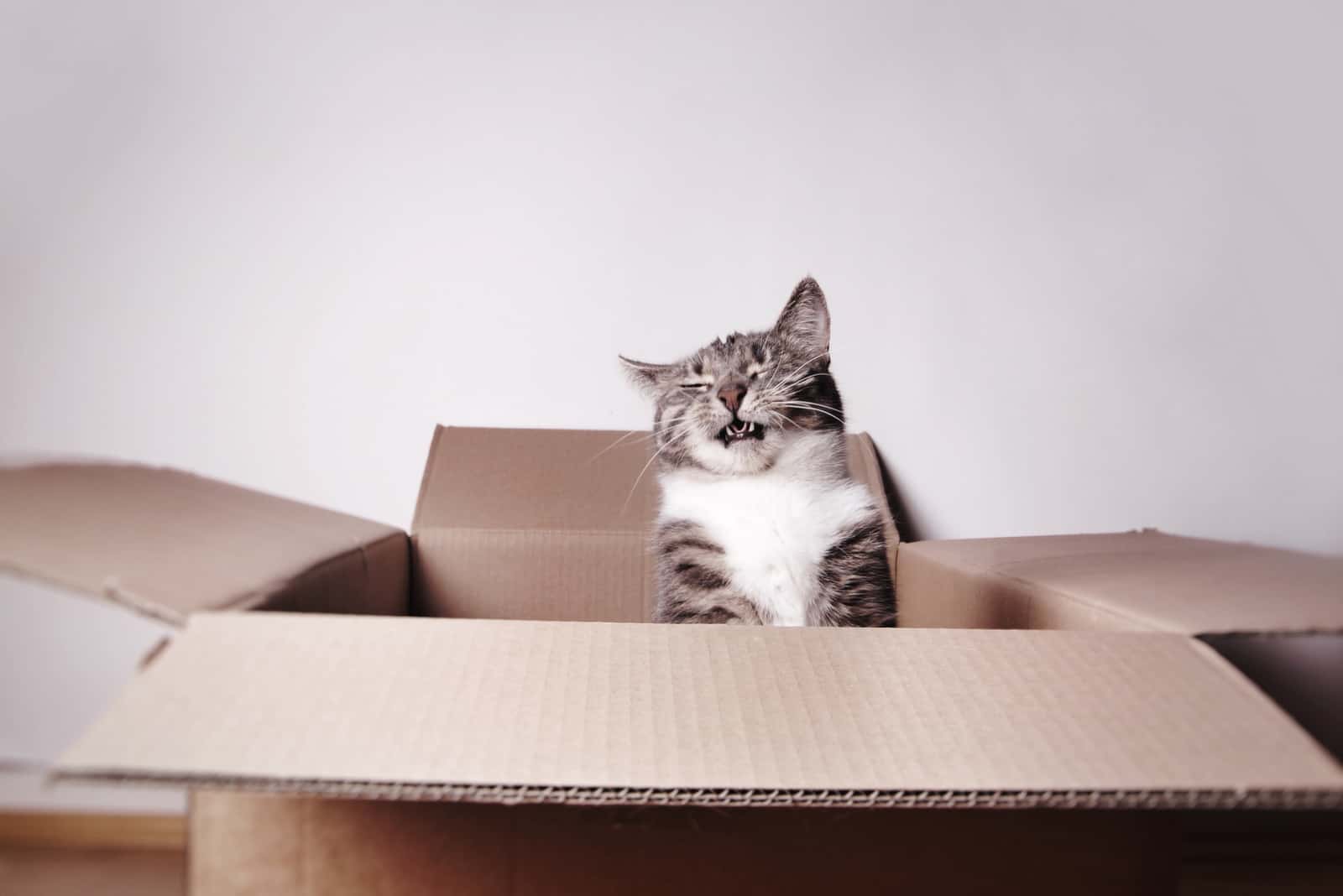
In this article, we have listed the most common causes of cat sneezing and watery eyes. The most probable cause of these symptoms is feline upper respiratory infection or, simply said, a cat cold.
This is usually nothing to be worried about, just keep track of the symptoms to ensure they are slowly going away as they should.
If you think your cat is not getting better (your cat is continuing to sneeze and having watery eyes), you might want to have a quick trip to the vet. The vet will find the cause and tell you what to do next in order to help your cat.
These symptoms can be caused by something more serious such as feline glaucoma, or something harmless that could turn into a bigger health issue such as pneumonia.
Your task is simply observing your cat and checking if symptoms are persistent or disappearing, as well as trying some symptom-relieving options.
Either way – your cat will appreciate the attention!

